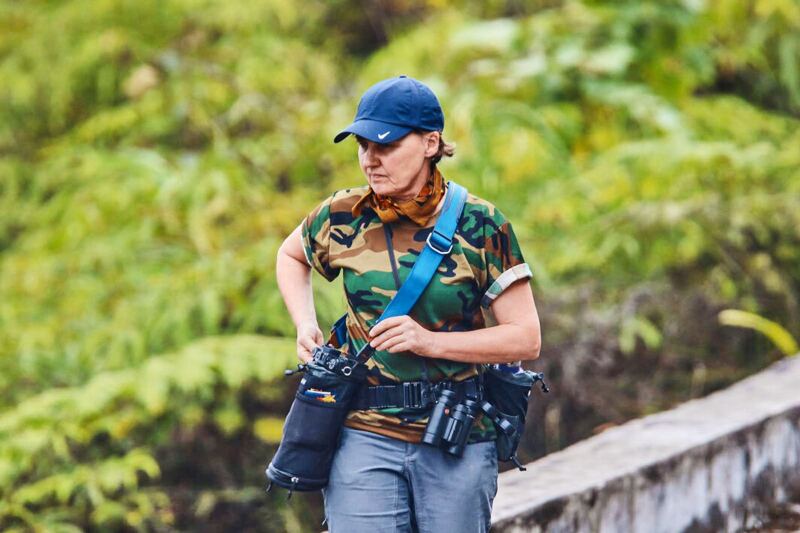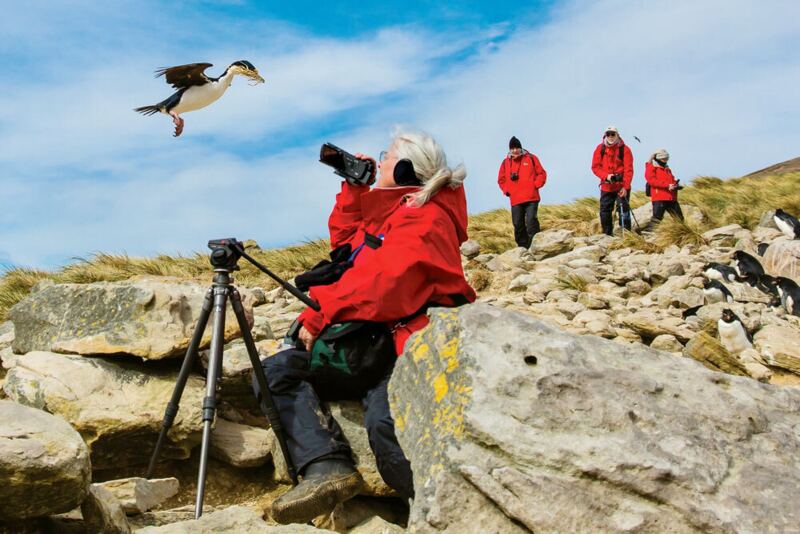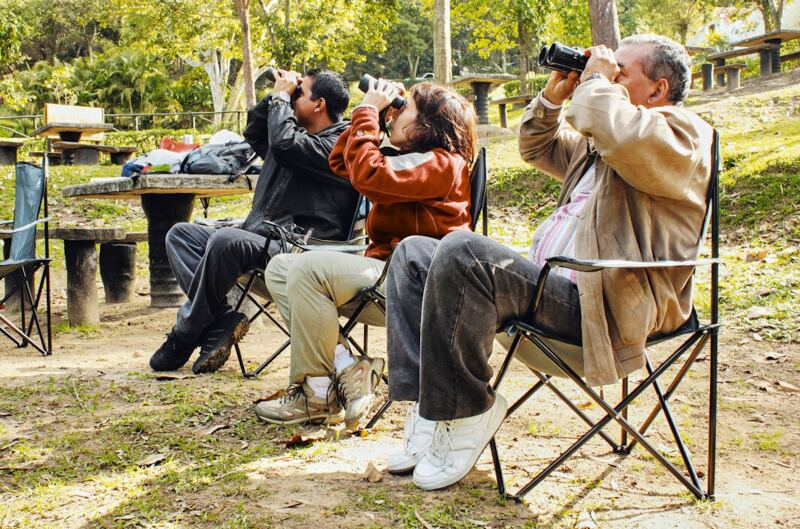Once you begin birdwatching, no street, sky, or forest ever looks the same. Birds are everywhere, and their comings and goings tell stories most humans aren’t attuned to. Hiring a guide or joining a birding group is worthwhile, whether to open your eyes to nature around a city or to lead you across pristine bird habitats on a once-in-a-lifetime expedition. Want to go it alone? Thanks to a slew of avian identification apps, self-guided birding has never been easier.
Birders Around the World

Courtesy of Susan Meyers
The Birder Helping Others Get Started
Susan Myers
Senior tour leader, Wings Birding Tours Worldwide
It’s very hard for me to define the joy I feel when I see a bird; it’s a bit like trying to define why you feel joy when you see a beautiful sunset or taste a fabulous laksa. I’ve been leading birding tours for more than 20 years, mostly in Southeast Asia, Japan, and India. The tropial rain forest is easily my favorite habitat, even though it’s hot and sweaty. The biodiversity is amazing. Never a dull moment. I can go back to the same place in Borneo dozens of times, and every time, I’ll see something new. It’s an assault on the senses: the sights and smells and sounds. Early in the morning— you start even before it gets light—you can hear songs some birds sing only before dawn. To prepare, buy a good pair of binoculars. Get the field guide for your local area and try to get out there as much as possible. I always tell people to not get obsessed with identifying every species. Try to get the groups down. Learn what woodpeckers look like, or barbets, broadbills, sunbirds. Then work on up from there.
The Birder Who Spots Similarities Between Birds and Humans
Joseph Tano
Birding guide, Trans Niugini Tours
I love my job. I take people around many different areas in Papua New Guinea, like I did for the BBC documentary Attenborough in Paradise with David Attenborough. Travelers come here to see some of the native or endemic species of New Guinea. There are birds of paradise, pitohuis, pigeons, cassowaries! More than 30 species of birds of paradise live here. The bird of paradise is like a human being. Human beings, they have a place to dance—to show off when they’re hoping to meet a partner. The bird of paradise does the same thing. They have a special place where they display themselves every year in July and August. The male and female meet up; the males wag their tails. They are so beautiful. The colors are truly unbelievable. You cannot resist watching them for the whole hour.
The Birder Who “Sees” By Sound
Michael Hurben
Member of the board of directors at Birdability, which works to introduce birding to people with disabilities and to ensure the outdoors is safe and accessible to everyone
At the time I discovered birding, I was living in Colorado, working on my PhD. At the park studying one day, I noticed a woodpecker on the ground, which seemed strange. I wanted to know what it was called. I knew I could go buy a field guide, and I did that, and I was able to identify the bird. And then I said, “Now I need to go see all the rest of them.” That’s how it started. Shortly afterward, I noticed something changing with my vision. Within a few years, I was diagnosed with retinitis pigmentosa, which is a genetic condition that means I don’t see at night or in dark conditions. During the day, I have tunnel vision. If you hold out your arm and look at the size of your fist—that’s about the size of the window I can see through. When the bird is in that spot, I can see it fine. It’s getting it into the window that’s the challenge. My wife and I went to Ecuador on a birding trip and we were stalking a very difficult bird, a species of fire-eye. The guide and my wife were both seeing this bird; it was skulking around in dense brush. They tried so hard to get me on it, and every time it moved, my eyes were in the wrong place. We must have spent an hour on this bird. I never saw it, and then it left. I was literally about to throw my binoculars on the ground. But then it occurred to me that the bird was singing and that I could record it. That changed my relationship with birding. I still get frustrated when I miss spotting a bird because of my eyesight. Some birders are aghast at the idea that you can count a bird because you’ve heard it. But why is seeing considered more important than hearing?
The Birder Focused on Finding Beauty Closer to Home
Sorrel Lyall
Blogger, wildlife artist, and final-year student at the University of Edinburgh, where she is president of the Ornithological Society
My grandparents are birders. That’s how I got into it. Birds just captured my imagination. You see a bird and you think, What’s that done today? What has its life been like? What decisions has it made that led it to come and feed here? I’m part of a growing community of birders in the U.K. who are low-carbon birders. As low-carbon birders, we want to protect not only the birds, but the planet. In the past year, I’ve decided I’m no longer going to fly anywhere. I bicycle when I can. But if it’s too far, then I will drive. You can’t be perfect. You can make certain decisions to reduce your impact, but you can’t do everything. It doesn’t have to be all or nothing. During the lockdown, I began to appreciate a lot more of what’s around me. In the autumn, you get loads of pink-footed geese coming in and birds from the Arctic. I really enjoy winter here, because we get a lot of winter migrants like Slavonian grebes or red-throated divers coming from Scandinavia. There are velvet scoters. They are jet black and have this orange bill and white stripe—they’re just gorgeous. Long-tailed ducks are another favorite. Winter is the time they’re in the most dramatic plumage. The males look amazing: blocks of gray, black, and white; a bit of pink; and a lovely long tail. My plan is to travel slowly and work along the way, winding my way around Europe. I’ve accepted the fact that I’m never going to see some rare endemic species on far-flung islands, because I’m not going to pay the carbon cost to travel there. Instead, I’m going to stay in one place for a long time and really get to know the bird life in each place. And that, for me, seems more fulfilling.
Over-the-Top Trips

Photo by Ralph Lee Hopkins
Brazil: Pantanal Safari
Victor Emanuel Nature Tours (VENT)
From $8,195
The Austin-based guiding service runs a 14-day trip to the Brazilian Pantanal four times a year, from July to September. Of the more than 100 tours VENT leads globally, founder Victor Emanuel says that the Pantanal Safari might be the most spectacular, with “special birds everywhere you turn,” including jabiru storks and bare-faced curassows. The tour starts and ends in Cuiabá, Brazil, and includes three days of boating on the Piquirí River, where travelers may see jaguars and giant otters in addition to throngs of raptors.
Kenya & Tanzania: Birds & Big Game
Rockjumper Worldwide Birding Adventures
From $9,295
East Africa is a must-see region for wildlife lovers, and a safari combining the best of Kenya and Tanzania will showcase hundreds of birds travelers can’t view anywhere else. On a small-group, 18-day trip with Rockjumper, visitors travel in top-of-the-line 4x4 vehicles, stay in comfortable lodges, and spend time in Kenya’s Amboseli National Park and Tanzania’s Ngorongoro Conservation Area. Upwards of 450 different birds call the areas home, so scores of flamingos are all but guaranteed, plus secretary birds, ostriches, hornbills, golden-winged sunbirds, vulturine guinea fowl, and Fischer’s lovebirds—in addition to Cape buffalos, lions, elephants, leopards, and rhinoceroses.
South Georgia & the Falklands
Natural Habitat Adventures/ Lindblad Expeditions
From $23,090
You visit these islands in the South Atlantic Ocean for spectacle, not for species diversity: The iceberg-studded vistas and enormous crowds of penguins are otherworldly sights. On this 14-day cruise, bookended by sightseeing in Argentina or Chile, travelers can spot the black-browed albatross, six species of penguin, and dozens of other pelagic birds, plus plenty of whales and seals. Natural Habitat Adventures, the world’s first 100 percent carbon-neutral travel company, operates this tour with Lindblad Expeditions, a National Geographic partner and leader in ecoconscious small-expedition cruises. “Seeing albatross with their massive wingspan, a hundred thousand king penguins at once, as well as several other penguin species, is something one never forgets,” says Wendy Klausner, a senior adventure specialist at Natural Habitat Adventures. “I loved it so much I did the trip twice.”
Urban Birding

Photo by Picturesque Japan/Shutterstock
New York City
In Central Park, sharp eyes could spot 100 different bird species just by scanning the trees, meadows, water, and outcroppings, but the park is only one of dozens of world-class birding sites in the city. With its varied habitats and location on the Atlantic flyway bird migration route, New York City plays host to more than 200 species a year, including red-winged blackbirds and American kestrels. For help finding them, take a free guided walk with New York City Audubon or the Brooklyn Bird Club.
New Orleans
Louisiana’s endangered wetlands provide ample opportunity for bird-watching. New Orleans, once the home of ornithologist John James Audubon, is a short drive from several marshes and beaches that serve as vital stopovers for a vast number of migratory birds each year. The hot spots include Grand Isle, Bayou Sauvage National Wildlife Refuge, Jean Lafitte National Historical Park and Preserve, and Big Branch Marsh National Wildlife Refuge. Visit in April to attend the Grand Isle Migratory Bird Celebration, or book a guided bird-watching walk with The Great Delta Tours any time of year to learn how the Mississippi River has helped mold regional avian diversity as well as the area’s culture and economy.
Hong Kong
More than 550 avian species have been identified in this relatively compact metropolis—many of them migratory—which means the best seasons for bird-watching are spring and autumn. The Mai Po Nature Reserve, a 45-minute taxi ride from the city’s Central business district, is a particularly rich area for spotting rare and endangered species such as the spoon-billed sandpiper. (You’ll need a permit, issued by the World Wildlife Fund, to enter the reserve.)
Cape Town, South Africa
This provincial capital is home to dozens of endemic birds, including the Cape sugarbird, Cape rockjumper, orange-breasted sunbird, and bank cormorant. The Strandfontein Sewage Works—lovelier in sight than name—is the city’s premier bird-watching spot, where birders may count more than 50 species on any given morning, including black-headed herons, flamingos, Cape longclaws, and African marsh harriers. The Cape Bird Club hosts regular free guided walks at other sites, and you can book a daylong bird-watching trip with Birding Africa or Cape Town Pelagics.
Get This Gear

Photo by Edgloris Marys/Shutterstock
Binoculars
Experienced bird-watchers caution that binoculars are intensely personal items and should be held up to your face before purchasing. “Whatever feels best in your hands is the one you should buy,” says Jon Feenstra, a senior tour leader at Wings Birding Tours Worldwide. The most commonly recommended size is 8x42, for steadiness and powerful magnification. Here are four models to consider:
For excellent value, birders point to this model, which is lightweight and under $300. If you can afford to spend a little more, go for the Nikon Monarch M7 8x42, which has a slightly wider field of view.
Vortex Optics Viper HD 8x42
$640
VENT chief operating officer Barry Lyon calls the midrange model “well-constructed with good quality glass and coatings.”
Maven B1.2 8x42
$950
A top pick for binoculars in the $500–$1,000 range, this pair earns points for clarity and brightness—plus, it has a particularly silky focus mechanism.
Zeiss Victory SF 8x42
$2,700
In-the-know guides laud these binoculars for their lenses, saying looking through them is “like seeing the bird for the first time again.” Audubon magazine also praises the “fast handling and tremendous field of view.”
Apps to Download
Sibley Birds
$20, available on iOS and Google Play
Consider this an indispensable mobile version of David Sibley’s The Sibley Guide to Birds, Second Edition, complete with detailed drawings and side-by-side species comparisons.
Merlin Bird ID
Free, available on iOS and Google Play
When you see a bird and want to identify it, Merlin—the best app for bird-watchers who are just starting out—asks three simple questions to narrow down your options. Snap a picture of your finding? Even better: Merlin’s Photo ID will pull up a match.
eBird Mobile
Free, available on iOS and Google Play
Like Merlin, eBird Mobile was created by the world-renowned Cornell Lab of Ornithology. Guides praise it as perfect for tracking what you’ve seen and where and comparing your notes with other users. All data is funneled to Cornell for worldwide bird research.











